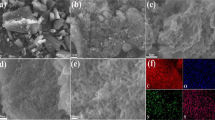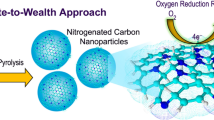Abstract
As a renewable resource, waste paper cannot only be recycled to paper, but also can be used as a new carbon source in the material field. In the present study, starting from the abundant and inexpensive materials, the three-dimensional (3D) framework cobalt (Co) and nitrogen (N) doped (Cox–N–C) electrocatalyst was successfully prepared using waste paper and urea via a facile hydrothermal treatment and ion adsorption process, followed by a further pyrolysis step. The experimental results show that the as-prepared Cox–N–C materials exhibit excellent electrocatalytic performance for hydrogen evolution reaction (HER). Especially, Co1.2–N–C sample has an outstanding HER catalytic activity with a 223 mV overpotential (at j = 10 mA cm−2), 91 mV dec−1 Tafel slope, and a remarkable long-term stability in 0.5 M H2SO4. Note that the abundant Co–N active sites are responsible for enhancing HER activity of Cox–N–C sample. It is expected that the low cost and highly efficient Co1.2–N–C electrocatalyst is a promising candidate to replace Pt noble catalysts.






Similar content being viewed by others
References
Cha HG, Choi K-S (2015) Combined biomass valorization and hydrogen production in a photoelectrochemical cell. Nat Chem 7:328
Puga AV (2016) Photocatalytic production of hydrogen from biomass-derived feedstocks. Coord Chem Rev 315:1
You B, Liu X, Jiang N, Sun YA (2016) General strategy for decoupled hydrogen production from water splitting by integrating oxidative biomass valorization. J Am Chem Soc 138:13639
Hisatomi T, Domen K (2019) Reaction systems for solar hydrogen production via water splitting with particulate semiconductor photocatalysts. Nat Catal 2:387
Yao J, Zheng Y, Jia X, Duan L, Wu Q, Huang C (2019) Highly active Pt3Sn-excavated nanocube cocatalysts for photocatalytic hydrogen production. ACS Appl Mater Interface 11:25844
Zhao Q, Sun J, Li S, Huang C, Yao W, Chen W (2018) Single nickel atoms anchored on nitrogen-doped graphene as a highly active cocatalyst for photocatalytic H2 evolution. ACS Catal 8:11863
Jiang K, Liu B, Luo M, Ning S, Peng M, Zhao Y (2019) Single platinum atoms embedded in nanoporous cobalt selenide as electrocatalyst for accelerating hydrogen evolution reaction. Nat Commun 10:1743
McAllister J, Bandeira NAG, McGlynn JC, Ganin AY, Song YF, Bo C (2019) Tuning and mechanistic insights of metal chalcogenide molecular catalysts for the hydrogen-evolution reaction. Nat Commun 10:370
Staffell I, Scamman D, Abad AV (2019) The role of hydrogen and fuel cells in the global energy system. Energy Environ Sci 12:463
Dincer I, Acar C (2015) Review and evaluation of hydrogen production methods for better sustainability. Int J Hydrogen Energ 40:11094
Mahmood N, Yao Y, Zhang J-W (2018) Electrocatalysts for hydrogen evolution in alkaline electrolytes: mechanisms challenges and prospective solutions. Adv Sci 5:1700464
Jin H, Liu X, Chen S, Vasileff A, Li L, Jiao Y (2019) Heteroatom-doped transition metal electrocatalysts for hydrogen evolution reaction. ACS Energy Lett 4:805
Huang L, Wu H, Liu H, Zhang Y (2019) Phosphorous doped cobalt-iron sulfide/carbon nanotube as active and robust electrocatalysts for water splitting. Electrochim Acta 318:892
Liu Y, Liang C, Wu J, Sharifi T, Xu H, Nakanishi Y (2018) Atomic layered titanium sulfide quantum dots as electrocatalysts for enhanced hydrogen evolution reaction. Adv Mater Interfaces 5:1700895
Ling T, Zhang T, Ge B, Han L, Zheng L, Lin F (2019) Well-dispersed nickel- and zinc-tailored electronic structure of a transition metal oxide for highly active alkaline hydrogen evolution reaction. Adv Mater 31:1807771
Yang J, Guo D, Zhao S, Lin Y, Yang R, Xu D (2019) Cobalt phosphides nanocrystals encapsulated by P-doped carbon and married with P-doped graphene for overall water splitting. Small 15:1804546
Dong X, Yan H, Jiao Y, Guo D, Wu A, Yang G (2019) 3D hierarchical V-Ni-based nitride heterostructure as a highly efficient pH-universal electrocatalyst for the hydrogen evolution reaction. J Mater Chem A 7:15823
Chunduri A, Gupta S, Bapat O, Bhide A, Fernandes R, Patel MK (2019) A unique amorphous cobalt-phosphide-boride bifunctional electrocatalyst for enhanced alkaline water-splitting. Appl Catal B 259:118051
Miao J, Lang Z, Zhang X, Kong W, Peng O, Yang Y (2018) Polyoxometalate-derived hexagonal molybdenum nitrides (MXenes) supported by boron, nitrogen codoped carbon nanotubes for efficient electrochemical hydrogen evolution from seawater. Adv Funct Mater 29:1805893
Zhao D, Dai J, Zhou N, Wang N, Xinwen P, Qu Y (2019) Prussian blue analogues-derived carbon composite with cobalt nanoparticles as an efficient bifunctional electrocatalyst for oxygen reduction and hydrogen evolution. Carbon 142:196
Peng Z, Wang H, Zhou L, Wang Y, Gao J, Liu G (2019) Hollow carbon shells enhanced by confined ruthenium as cost-efficient and superior catalysts for the alkaline hydrogen evolution reaction. J Mater Chem A 7:6676
Ko D, Jin X, Seong K-d, Yan B, Chai H, Kim JM (2019) Few-layered MoS2 vertically aligned on 3D interconnected porous carbon nanosheets for hydrogen evolution. Appl Catal B 248:357
Liang H-W, Bruller S, Dong R, Zhang J, Feng X, Mullen K (2015) Molecular metal-Nx centres in porous carbon for electrocatalytic hydrogen evolution. Nat Commun 6:7992
Gao R, Guo H, Wang B (2019) Co based N, S co-doped carbon hybrids for catalytic hydrogenation: role of cobalt salt and doped S. Appl Catal A 579:99
Guo H, Wang B, Qiu P (2019) N, S-codoped carbon shells embedded with ultrafine Co NPs for reductive amination with formic acid. ACS Sustain Chem Eng 7:8876
Fei H, Dong J, Arellano-Jimenez MJ, Ye G, Dong KN, Samuel EL (2015) Atomic cobalt on nitrogen-doped graphene for hydrogen generation. Nat Commun 6:8668
Wang Z-L, Hao X-F, Jiang Z, Sun XP, Xu D, Wang J (2015) C and N hybrid coordination derived Co-C-N complex as a highly efficient electrocatalyst for hydrogen evolution reaction. J Am Chem Soc 137:15070
Lai J, Huang B, Chao Y, Chen X, Guo S (2019) Strongly coupled nickel-cobalt nitrides/carbon hybrid nanocages with Pt-like activity for hydrogen evolution catalysis. Adv Mater 31:1805541
Thambiraj S, Shankaran DR (2016) Green synthesis of highly fluorescent carbon quantum dots from sugarcane bagasse pulp. Appl Surf Sci 390:435
Boyjoo Y, Cheng Y, Zhong H, Tian H, Pan J, Pareek VK (2017) From waste Coca Cola (R) to activated carbons with impressive capabilities for CO2 adsorption and supercapacitors. Carbon 116:490
Ji R, Zhang M, Ma W, Zhu Z, Ma CC, Huo PW (2019) Heterojunction photocatalyst fabricated by deposition Co3O4 nanoparticles on MoS2 nanosheets with enhancing photocatalytic performance and mechanism insight. J Taiwan Inst Chem E 97:158
Zhao X, Yu H, Liu Y (2019) Boosting the hydrogen evolution activity of a Co-N-C electrocatalyst by codoping with Al. RSC Adv 9:33997
Sa YJ, Park SO, Jung GY (2019) Heterogeneous Co-N/C electrocatalysts with controlled cobalt site densities for the hydrogen evolution reaction: structure-activity correlations and kinetic insights. ACS Catal 9:83
Wang Z-L, Hao X-F, Jiang Z (2015) C and N hybrid coordination derived Co-C-N complex as a highly efficient electrocatalyst for hydrogen evolution reaction. J Am Chem Soc 137:15070
Yang CC, Zai SF, Zhou YT, Du L, Jiang Q (2019) Fe3C-Co nanoparticles encapsulated in a hierarchical structure of N-doped carbon as a multifunctional electrocatalyst for ORR, OER, and HER. Adv Funct Mater 29:1901949
Prabu N, Saravanan RSA, Kesavan T (2019) An efficient palm waste derived hierarchical porous carbon for electrocatalytic hydrogen evolution reaction. Carbon 152:188
Wu Z-Y, Ji W-B, Hu B-C, Liang H-W, Xu X-X, Yu Z-L (2018) Partially oxidized Ni nanoparticles supported on Ni-N co-doped carbon nanofibers as bifunctional electrocatalysts for overall water splitting. Nano Energy 51:286
Hu C, Dai L (2017) Multifunctional carbon-based metal-free electrocatalysts for simultaneous oxygen reduction, oxygen evolution, and hydrogen evolution. Adv Mater 29:1604942
Dong R, Zheng Z, Tranca DC (2017) Inside cover: immobilizing molecular metal dithiolene-diamine complexes on 2D metal-organic frameworks for electrocatalytic H2 production. Eur J 23:2255
Zhang J, Dai L (2016) Nitrogen, phosphorus, and fluorine tri-doped graphene as a multifunctional catalyst for self-powered electrochemical water splitting. Angew Chem 55:13296
Hou Y, Wen Z, Cui S (2015) An advanced nitrogen-doped graphene/cobalt-embedded porous carbon polyhedron hybrid for efficient catalysis of oxygen reduction and water splitting. Adv Funct Mater 25:872
Li Y, Wang Y, Pattengale B (2017) High-index faceted CuFeS2 nanosheets with enhanced behavior for boosting hydrogen evolution reaction. Nanoscale 9:9230
Wang Y, Nie Y, Ding W (2018) Unification of catalytic oxygen reduction and hydrogen evolution reactions: highly dispersive Co nanoparticles encapsulated inside Co and nitrogen co-doped carbon. Chem Commun 51:8942
Acknowledgements
This work was financially supported by the Natural Science Foundation of Shanghai (19ZR1420200), Science and Technology Commission of Shanghai Municipality (14DZ2261000 and 19DZ2271100) and Shanghai Committee of Science and Technology (17DZ2282800).
Author information
Authors and Affiliations
Corresponding author
Additional information
Publisher's Note
Springer Nature remains neutral with regard to jurisdictional claims in published maps and institutional affiliations.
Supplementary Information
Below is the link to the electronic supplementary material.
Rights and permissions
About this article
Cite this article
Sun, H., Xue, L., Shi, Y. et al. Waste paper derived Co, N co-doped carbon as an efficient electrocatalyst for hydrogen evolution. Reac Kinet Mech Cat 132, 1137–1150 (2021). https://doi.org/10.1007/s11144-021-01956-3
Received:
Accepted:
Published:
Issue Date:
DOI: https://doi.org/10.1007/s11144-021-01956-3




